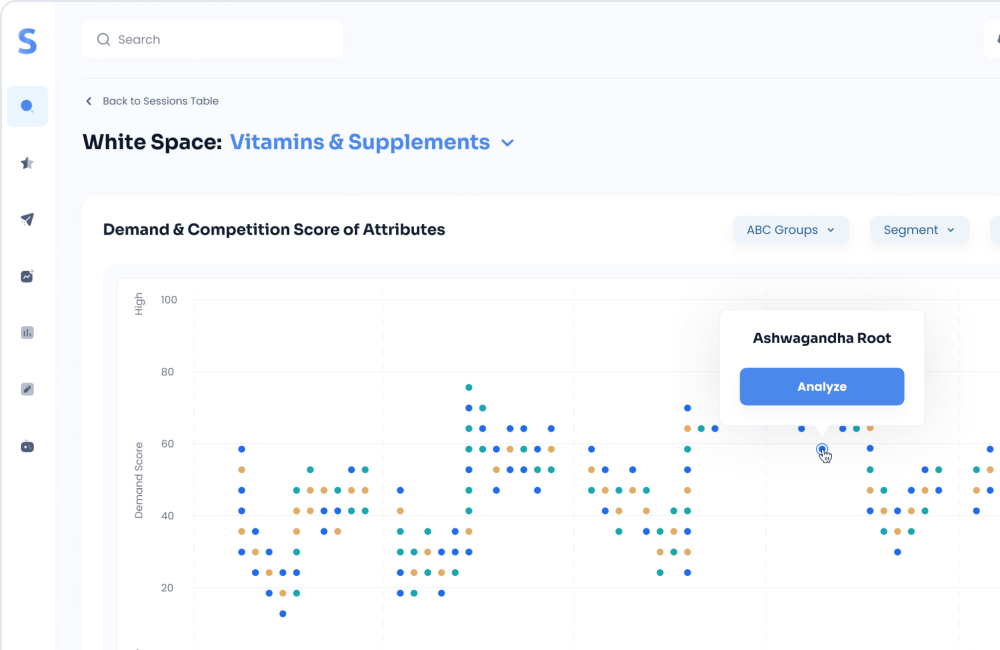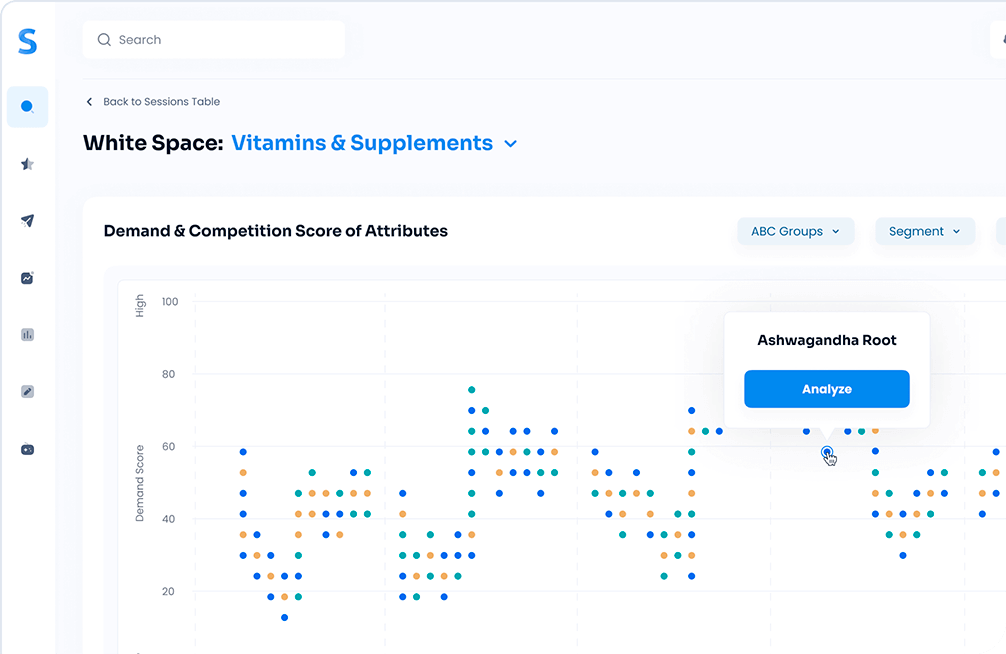Introduction
In the increasingly competitive landscape of the Consumer Packaged Goods (CPG) industry, the ability to identify and capitalize on hidden market opportunities is what sets leading companies apart. Hidden market opportunities are often tucked away in overlooked consumer needs, rising trends, or emerging niches. Businesses that can recognize and harness these opportunities hold a significant advantage, as they can tap into markets that competitors may not yet have on their radar.
At the same time, the successful exploitation of these opportunities often involves identifying untapped consumer segments—groups of consumers whose needs or desires are not being fully met by current offerings in the market. These segments represent potential customers who are seeking products or experiences that they cannot find, and companies that can fulfill these unmet needs have a chance to acquire and retain these consumers.
In this comprehensive guide, we will explore the importance of uncovering hidden market opportunities in the CPG industry, discuss effective strategies for identifying untapped consumer segments, and delve into the role of Artificial Intelligence (AI) in this process. Additionally, we’ll look at real-world success stories where businesses have effectively leveraged these opportunities and explore how AI-powered tools like Simporter can play a pivotal role in this exploration.
Join us on this journey to delve deep into these hidden opportunities and transform them into tangible business outcomes. Let’s start by understanding the very concept of hidden market opportunities in the CPG context.
Understanding the Concept of Hidden Market Opportunities

Hidden market opportunities represent potential areas of growth that are often overlooked, undervalued, or yet to be explored by businesses. In the context of the CPG industry, these opportunities can manifest in various ways—emerging consumer trends, gaps in the market, untapped geographies, unmet consumer needs, or evolving preferences.
The advent of globalization and digitalization has ushered in a new era of dynamic consumer behavior. Consumers today are more informed, connected, and demanding than ever before. Their choices are influenced by various factors—environmental impact, health and wellness, convenience, and affordability, among others. As their expectations evolve, so do the opportunities for innovative CPG companies to meet these needs.
Untapped consumer segments form a significant part of these hidden opportunities. These segments include groups of consumers whose specific needs are currently unmet by existing market offerings. For instance, it could be health-conscious consumers looking for plant-based snacks, busy millennials demanding convenience-driven meal solutions, or environmentally-aware consumers seeking sustainable product alternatives. Tapping into these segments requires a deep understanding of their specific needs, preferences, and motivations.
Spotting these hidden opportunities, however, is no walk in the park. It requires businesses to go beyond traditional market research and employ innovative tools, methodologies, and technologies. Businesses need to be inquisitive, proactive, and observant—keeping a close eye on evolving consumer trends, understanding shifts in consumer behavior, and identifying patterns that could signify a potential market opportunity.
Furthermore, uncovering hidden market opportunities holds immense business value. It allows businesses to:
- Expand their consumer base: By identifying and addressing unmet consumer needs, businesses can attract new customers, thus expanding their market presence.
- Stay ahead of the competition: Companies that can spot and act on these opportunities often gain a competitive edge as they offer unique value propositions that differentiate them from the crowd.
- Drive innovation: Hidden market opportunities often serve as a breeding ground for innovation, enabling businesses to develop unique products, services, or marketing strategies.
- Boost revenues and profitability: New opportunities often translate into increased sales and profitability as businesses cater to unmet needs and gain customer loyalty.
Let’s take a closer look at these untapped consumer segments next.
Identifying Untapped Consumer Segments

Uncovering hidden opportunities often begins with identifying untapped consumer segments. These are subsets of the market that are not being adequately serviced by current offerings, and therefore, present ripe opportunities for innovation and growth. But how can companies pinpoint these elusive segments?
To start with, thorough market research is the cornerstone of any successful consumer segmentation strategy. By collecting and analyzing data on consumer demographics, behavior, needs, and preferences, businesses can identify potential gaps in the market. However, the key is to dive deeper than surface-level data to understand the factors driving consumer behavior.
Observing consumer behavior can be especially enlightening. Not just what consumers are buying, but why they’re making these choices. This includes studying how consumers interact with products, what they value, their lifestyle, and their aspirations. It’s about listening to the conversations happening online and offline to spot emerging patterns and trends.
Social listening tools, for instance, can monitor social media platforms, blogs, forums, and other online spaces for mentions of keywords, brand names, or topics relevant to your industry. By doing so, they can identify emerging trends, common complaints, or unfulfilled needs that may signal a new consumer segment.
Surveys and focus groups can also provide qualitative insights into consumer attitudes and preferences. They can help businesses understand why consumers prefer certain products, what problems they are facing, or what needs are unfulfilled.
Moreover, analyzing competitor strategies can shed light on opportunities being overlooked. Understanding your competitor’s customer base, their successful and unsuccessful ventures, and their gaps can help identify areas your business can exploit.
Nowadays, advanced analytics and AI tools are also playing a pivotal role in identifying untapped consumer segments. By mining large volumes of data and applying sophisticated algorithms, these tools can uncover patterns and correlations that would be impossible for humans to spot, enabling businesses to pinpoint potential untapped segments.
However, identifying untapped consumer segments is just the first step. Businesses must also understand how to tailor their products, marketing, and overall strategy to cater to these segments effectively. The importance of getting this right cannot be overstated, as it can mean the difference between a product that resonates with consumers and one that falls flat. In the following section, we will explore how AI comes into play in unveiling these hidden market opportunities.
The Role of AI in Unveiling Hidden Market Opportunities

Artificial Intelligence (AI) has revolutionized the process of identifying hidden market opportunities and untapped consumer segments. AI’s profound impact comes from its ability to analyze vast amounts of data, uncover complex patterns, and deliver insights in real time. This gives businesses the leverage to stay ahead of the curve in a highly competitive market.
AI-powered consumer insight platforms ingest and analyze data from a myriad of sources such as social media, customer reviews, market reports, and more. This data is processed using advanced algorithms to reveal emerging trends, sentiment towards products or brands, unmet consumer needs, and potential new market segments. This holistic approach provides a comprehensive understanding of the market landscape.
Moreover, AI’s predictive capabilities are instrumental in unveiling hidden opportunities. By examining historical and current data, AI can forecast future trends and market shifts. This predictive power is vital, especially in volatile markets where consumer behavior can rapidly change.
Notably, AI’s natural language processing (NLP) capabilities aid in understanding consumer sentiment. NLP analyzes written text from sources like social media posts, customer reviews, or forum discussions to identify common themes, sentiment, and opinions. This deep-dive into customer language can reveal pain points, desires, or trends that businesses can harness to discover hidden opportunities.
Another crucial aspect of AI is its ability to personalize customer experiences. AI can analyze individual consumer behavior and preferences to deliver tailored recommendations, enhancing customer engagement and loyalty. This personalization aids businesses in identifying niche segments and customizing their offerings to meet these unique needs.
In the Consumer Packaged Goods (CPG) industry, AI has particular utility in new product development. By examining thousands of product characteristics, consumer trends, and market data, AI can suggest potential product ideas. This allows businesses to innovate faster and more accurately, reducing the risk of product failure and creating a clear path to market success.
A practical example would be AI detecting an increasing interest in vegan, gluten-free snacks among young consumers. This trend could signal a hidden opportunity for a CPG company to develop a new line of vegan, gluten-free snacks targeting this segment. The early detection and strategic response to this trend could provide the company a significant competitive advantage.
However, while AI holds immense potential, it’s not a magic wand. The success of AI in uncovering hidden opportunities significantly depends on its strategic application. Businesses must use high-quality data, ask the right questions, and incorporate AI insights into their decision-making processes.
In essence, the use of AI in unveiling hidden market opportunities has proven to be an invaluable tool. It helps businesses stay nimble, innovate proactively, and ultimately secure a competitive edge in an ever-changing market.
Case Study: How Gatorade Entered Adult Gummy Market

To underscore the potential of identifying hidden market opportunities and utilizing AI in this process, let’s consider an enlightening case study from the sports beverage industry.
Gatorade’s Strategic Venture into the Adult Gummy Market
One of the most compelling instances of unveiling hidden market opportunities comes from PepsiCo’s popular sports drink brand, Gatorade. Known for its sports hydration products, Gatorade expanded its product line in October 2022 to include adult gummy vitamins.
The company launched two products under this line, named Recovery and Immunity. The Recovery product was a strategic fit with Gatorade’s sports nutrition theme, featuring ingredients like tart cherry powder and vitamin D, offering a healthy way to support post-exercise recovery. On the other hand, the Immunity product positioned itself as a differentiated offering in the crowded immunity supplements market, targeting a niche group – athletes.
The move into the adult gummies market was a significant strategic decision, backed by data insights revealing an emerging market trend. By utilizing the Gatorade brand’s athletic profile, the company was able to create products that met specific customer needs, rather than launching generic supplements. This approach significantly reduced the risk of product failure and allowed the company to carve out a new market niche.
The lesson from Gatorade’s story is that identifying and leveraging hidden market opportunities doesn’t always mean being the first to market with a groundbreaking product. Instead, it’s about observing patterns, identifying consumer needs that are unfulfilled, and developing products that meet those needs.
In Gatorade’s case, it’s about finding white space opportunities by creating products that serve a specific consumer group. Rather than launching a broad-appeal immune support vitamin, the company chose to target a particular consumer group, and this precision paid off.
In conclusion, the Gatorade case study highlights the power of identifying hidden market opportunities and how they can lead to innovative product ideas and new market entry strategies. It’s a testament to the effectiveness of AI-backed trend analysis and predictive modeling, demonstrating the potential for significant growth and diversification.
How Simporter Helps Identify Untapped Consumer Segments

While unveiling hidden market opportunities is no easy feat, modern technological advancements make this challenge more manageable. Specifically, artificial intelligence plays a crucial role in identifying and capitalizing on these opportunities, and Simporter stands at the forefront of this AI-powered revolution.
Simporter is an AI-driven platform designed for Consumer Packaged Goods (CPG) brands that facilitate the task of researching new products, connecting data, and recommending actionable steps. It leverages AI’s computational prowess to scan vast volumes of data from multiple sources, including product descriptions, customer reviews, social media data, and search patterns. This holistic analysis allows Simporter to identify patterns across data sets, revealing otherwise hidden market opportunities.
Notably, Simporter possesses the capability to single out white space opportunities by creating products that cater to specific consumer groups. As demonstrated in the Gatorade case study, this ability to target niche segments can spell the difference between a successful product launch and an unsuccessful one.
In essence, Simporter equips businesses with the capability to convert big data into big opportunities. Its AI algorithms empower companies to not just keep pace with market trends but anticipate and respond to them in a strategic manner, thereby driving competitive advantage and growth.
Conclusion: The Competitive Advantage of Unveiling Hidden Market Opportunities
Unveiling hidden market opportunities and identifying untapped consumer segments represent the core strategies for achieving sustainable growth in today’s competitive Consumer Packaged Goods landscape. These approaches provide businesses with the vital knowledge to align their product innovation and marketing strategies with emerging customer needs and preferences. More importantly, it paves the way for businesses to differentiate themselves, offering unique value propositions that resonate with niche segments.
Leveraging AI-powered tools like Simporter to achieve these goals isn’t merely a trend—it’s a paradigm shift in how businesses approach market analysis and strategic planning. By harnessing AI’s predictive capabilities and data mining prowess, businesses can transform extensive market data into actionable insights, enabling more precise decision-making, superior product development, and increased customer satisfaction.
Ultimately, the ability to unveil hidden market opportunities isn’t just about spotting trends. It’s about foreseeing the future of consumer behavior, being one step ahead, and responding proactively. It’s about using AI-driven insights to identify and cater to untapped consumer segments, setting the stage for innovative product development and enhanced market relevance. For businesses keen on driving growth and staying competitive, the exploration of these hidden opportunities isn’t just an option—it’s imperative.









